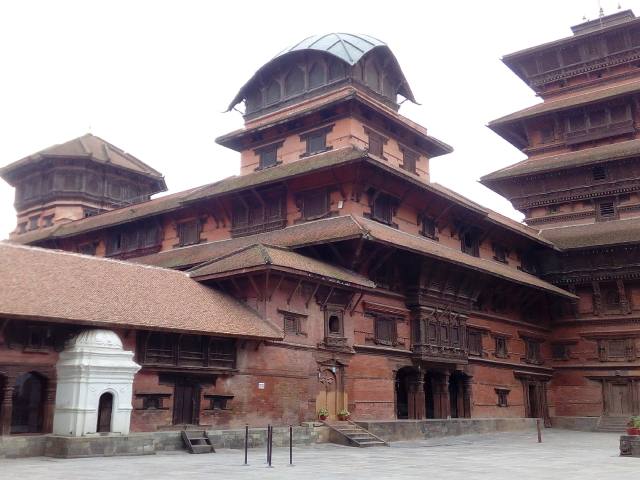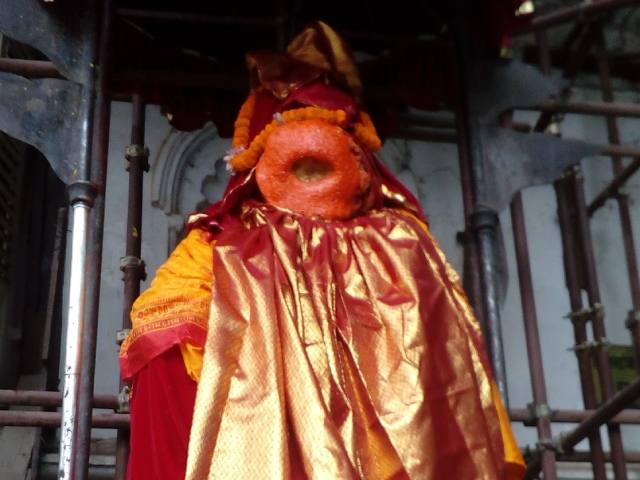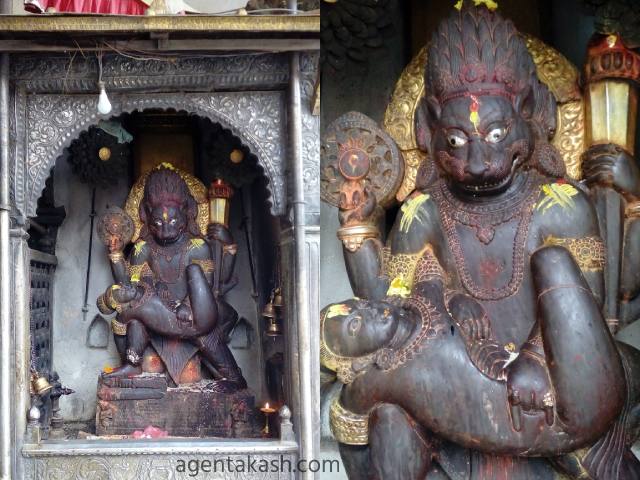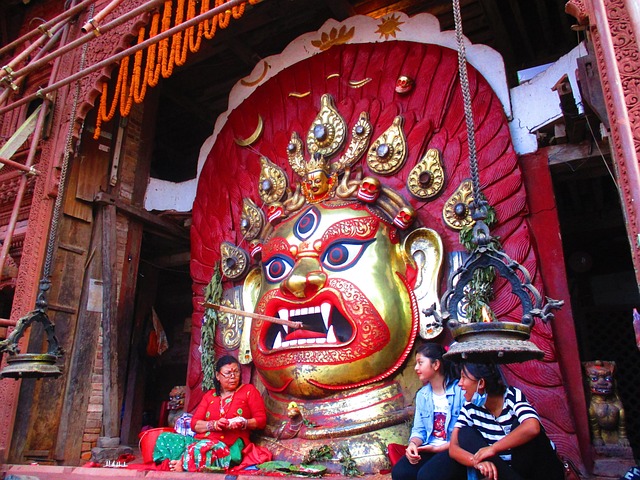Before talking about Kathmandu durbar square let’s talk about it’s history. It is said once upon a time Kathmandu valley was a lake and it has been geologically verified that a lake did exist in the Valley. According to the legend the Bodhisattva Manjushri came to Chobhar Hill and cut the hill with his flaming sword to release the water of an enormous lake. Kathmandu was also known as Kantipur in those days. According to the Bhasa Vanshavali King Gunkamdeva is the founder of Kathmandu.
Kathmandu Durbar Square / Hanuman dhoka Durbar Square is a very old palce of Nepal which has cultural and historical importance. The UNESCO cultural Site Hanuman dhoka Durbar is named from God Hanuman located infornt of the palace’s main entrance gate. It was installed by king Pratap Malla in 1672. In Nepali language “dhoka” means gate. It is believed that God Hanuman protect them from evils and enemies. It already existed in the 7th century. Hanuman dhoka Durbar was enlisted as a UNESCO World Heritage Site in 1979. The Malla rulers build it and Shah dynasty rulers, Rana rulers have also contributed to the complex by adding sections to the existing buildings. Kathmandu Durbar Square is a complex of structures of the royal palaces, towers, monuments, temples of pagoda, sikhara and dome architectural styles etc. It is also known as “Layaku” in local language Nepalbhasa.

Around Kathmandu durbar square
Royal complex
Bangla
Bangla tower has unique curvy copper roof design which came into existence after the renovation after 1990 B.S. (B.S. stands for Bikram sambat) earthquake.
Nautale Durbar / Basantapur Kailash
Basantapur Kailash, the nine storeyed tower which is popularly known as Nautale Durbar by locals. It was built by King Prithivi Narayan Shah for residence and inspection. In those days it might be one of the tallest building in the country.
Bilas Mandir
Bilas Mandir lies on the southeastern part of the Lohan Chowk and Bilas means enjoyment or relaxation. Shah rulers used it for entertainment purposes.
Gaddi Baithak
Gaddi Baithak was built by Prime Minister Chandra Shumsher Jung Bahadur Rana in 1908 after his return from Europe visit and it has neo-classical European design. It is the latest addition to the Kathmandu durbar square. It was used as a meeting quarters by the Rana rulers, Shah kings. The kings used to observe Indra Jatra festival from the western balcony of the Gaddi Baithak. After end of monarchy in Nepal head of the state is invited to observe the festival.
Laxmi Bilas Mandir
Laxmi Bilas Mandir was used by the Shah rulers to pray to the Hindu goddess of wealth Laxmi.
Malla Kalin Dhukuti
Malla kalin dhukuti was a treasury used by the Malla rulers, holds the valuables from the Malla era which were created as a backup to overcome unknown future economic crisis.
Shah-Kalin Dhukuti
Shah kalin dhukuti was a treasury used by the Shah rulers located in the Bhandarkhal Garden. Later, Shah Kings treasury was moved to the Narayanhiti Royal Palace.
Sisa Baithak
Sisa means glass and Sisa Baithak means Glass hall. It was used by the Malla kings for meetings and observing events. Glass was rare in the time of construction of the Sisa Baithak.
Swarna Dwar
Swarna Dwar means the Golden gate. Copper was sold and gold was purchased to mould the Swarna Dwar. It is the main entrance to the palace with one male lion and other female lion on it’s either side. Lord Shiva is riding on the male lion and Goddess Parvati is riding on the female lion. At top the gate there is icon of Vishwarup (krishna’s god form showed to Arjun during Mahabharata) of Lord Krishna.
Courtyards
Bayu Chowk

Bayu Chowk is named from the air god temple located within the courtyard and it is also known as Lamo chowk as it has long shape.
Dakh Chowk
Dakh Chowk used to be the cultivating field for grapes before building the palace premises, so it was named Dakh chowk from the tropical bengali grape Dakh.
Lohan Chowk
King Prithivi Narayan Shah built the Lohan Chowk as the residential quadrangle for the Shah rulers and used throughout their rule before migration to Narayanhiti palace in Kathmandu.
Masan Chowk (Kanhel Chowk)
During the Malla era, Masan Chowk used to be Kanhehol chowk because Karbir flower used to be grown. In Newari, Karbir flower is called as Kanhehol in local language Nepalbhasa.
Mohan Chowk
Mohan Chowk is the most magnificent courtyard among all courtyards of Hanuman dhoka durbar. It was also the main residential quadrangle of the Malla kings, built by King Pratap Malla in 1649 AD. It is also known as Mohankali Chowk. There is a golden water spout at the center of the courtyard famous for it’s architectural design and water was brought from the hills of the Budhanilkantha by the King Pratap Malla. It was also used to welcome foreign state heads, diplomacies and no one could enter this end of the palace not even other members of the royal family without permission of the King. It is believed a prince had to be born in this quadrangle to be considered eligible for being a ruler and King Jay Prakash Malla (the last king of Malla dynasty), was not born in this courtyard and as a result he lost the kingdom to Prithivi Narayan Shah.
Mul Chowk
The word Mul means principal, Mul Chowk was used for events and rituals of Malla princes and kings such as wedding ceremonies, coronation, barta-bandha etc. During the 9th day of Dashain festival in Nepal, the central space is used to offer sacrifices of buffalos and goats. It’s floor will be red and wet with blood of buffalos and goats.
Nasal Chowk
Nasal Chowk is another important place, the biggest courtyard of the Hanuman Dhoka Palace which has been named after the Nasadyo, Natyeshwor or Nasaleshwor temple. Nasa-dyo is dedicated to the god of art, here dyo means God in Nepalbhasa. People worship Nasadyo for blessings for learning music, dance etc. It is important place because it was used as a meeting spacewith the public or with foreigns, royal theatre during the Malla era and the place where coronations of the Shah Kings were held until the end of the Monarchy in Nepal. Natyeshwor temple is a temple dedicated to Lord Shiva’s dancing form. Shiva has different forms, Natyeshwor is among one of them. Natyeshwor temple lies on the eastern front of the courtyard.
Nhula Chhen Chowk
The word “Nhu” means new in Nepalbhasa and Nhula Chhen means “new home”, chhen means home in the local language Nepalbhasa. After victory over Malla king of Kathmandu King Prithivi Narayan Shah of Gorkha entered Hanuman dhoka palace through Nhula Chhen chowk. It was the residence quarter of the king and his bedsheets are on display to the public.
Sundar Chowk
Sundar Chowk was mostly used by the Malla queens which can be entered through the door at the western front of the Mohan Chowk. It was built by King Pratap Malla with a golden water spout. There is a Kaliyadaman statue, considered to be one of the rarest masterpiece of stone architecture which depicts the story of Lord Krishna subduing the evil serpent Kaliya.
Trisul Chowk
Trisul Chowk has been named after a trishul that has been placed at the base of the Taleju temple and there is three gigantic columns standing on the top of a tortoise, at the center of the courtyard. During Malla era, it used to be a place to perform and showcase different cultural dances.
Temples and monuments
Agam Chhen Mandir
Agam Chhen Mandir means hidden private temple, only the Malla rulers were allowed to enter here. Normally, in Agam room other people are not allowed in Bajracharya caste also. There is a deity of the Malla kings in Agam Chhen.
Akash Bhairav Temple
TAkash Bhairav is the God of the Sky. This is a beautiful bronze and gold temple with head of Akash Bhairav which is taken out of the temple once a year during the festival of Indra Jatra.
Bhagwati Mandir
Bhagwati Mandir is a temple is the home to the goddess Nuwakot Bhagwati.
Big Bell and drums
During the reign of Rana Bahadur Shah, These bell and drums were used during the worshipping ritual of the Goddess Taleju and also used as an alarm and to make important announcements those days. There is a huge bronze bell and two giant drums. You can see it from the road displayed on first floor of a building near Chasin Dega.
Chasin Dega
Chasin Dega is also known as “Krishna temple” dedicated to Lord Krishna, his wives Rukmini and Satyabhama. It was built by King Pratap Malla in memory of his two queens in 1649. It is unique than other temples which has an octagonal shape.
Chaturmukh Shiva Mandir
Chaturmukh Shiva Mandir has the four faced icon of Lord Shiva. It is in the form of Shiva Linga.
Dashain Ghar
Dashain Ghar is the storehouse for royal jamaras brought from Gorkha and then the jamaras would be sent to the Narayanhiti Palace. Jamara is grown during the festival of Dashain.
Hanuman statue
Hanuman statue is situated at the entrance of the Hanuman Royal Palace. In 1672, the statue was build by King of Kathmandu valley Pratap Malla. He was spiritual and tantrik king, with tantrik power he made mouth of Hanuman wide open and offer laddu in Hanuman’s mouth. The structure has an umbrella over its head, is covered in red cloth and face painted orange color. Only male can touch this statue, females cannot touch God Hanuman and he is the devotee of Lord Ram.

Jaganath Temple
The Jagannath temple is one of the oldest temples in Kathmandu Durbar Square where you’ll find the erotic wooden carvings on the outter part. It was built by the king Mahendra Malla in 1563. This temple is dedicated to Lord Vishnu. It is not known why these erotic carvings was carved on the temple but some believe that these were carved to protect the temple from lightning.
There is no scientific reason to prove it but there is a saying that lightning is a virgin. The erotic carvings scenes help to drive her away as she views such subjects with utter disgust. You’ll see this type of carvings on some other temples of Nepal also. The real reasons behind the erotic scenes are as mysterious.
You may also like to know the reason behind it in detail – What is the reason behind the carving of erotic art over the temples ? In this article we’ve tried to explain it from different aspects such as Thunder and Lightning, Tantra, Shiva and Shakti and Alternative theories.
Jalasayan Narayan Pokhari
Jalasayan Narayan is the icon of the sleeping Narayan and pokhari means pond around the sleeping God Narayan.
Jaldroni
King Pratap Malla was fluent in 14 languages. There is a 14 script inscription installed located near the Hanuman statue.
Kageshvar Temple
Kageshvar Temple was built in 1711 by Queen Bhuvana laxmi. This temple is little different from others as it’s lower storey is built in a local Newa architecture style and the upper storey is built in the shikhara style.
Kal Bhairav Shrine
Six armed Kal Bhairav is wearing a crown imbedded with skulls, earrings of snake, his hand is holding a head. Kal Bhairav was once known as “Adalat” which means court in Nepali language. People were brought in-front of Kal Bhairav so that they would be forced to tell the truth. It is believed that the people who lied before the Bhairav is said to die immediately, vomiting blood. Suspects were brought in front of the large fierce sculpture of Kal Bhairav to speak the truth.
Kasthamandapa
According to the legend the Kasthamandapa was built from the wood of a big single tree and in the 11th century, the first reference to the structure is recorded. It’s origin and exact age are unknown till today. It is also a pilgrim shelter in those days known as “Mar Satal” in local language. Built in the Mandapa style, Kasthamandapa is 19 meters tall in height and 21 meters wide. There is a long wooden stairway leads to the first floor and traditional tiles cover the roofs. At center there is a statue of guru Gorakhnath, a mahayogi who is wordshipped not only by normal people but also by royal family of Nepal. There is statues of four different Ganesh on four corners.
Kotilingeshwar Temple
A dome-style temple the Kotilingeshwar Temple was built by Mahendra Malla dedicated to Lord Shiva. The stone temple has a chaturmukha (four faced) lingam which is the central shrine.
Kumari and Kumari Ghar
Kumari is the living Goddess and Kumari Ghar is the place where Godess Kumari lives with her caretakers. In Nepali “Ghar” means house. The legend says living Goddess Kumari is the incarnation of Goddess Taleju. Spirit of Goddess Taleju is incarnated as a little girl among the Shakya caste which is one of the Newa cast of Nepal. Inner courtyard of Kumari Ghar is well decorated with beautiful carvings.
Mahendreshwar temple
The Mahendreshwar temple is a temple dedicated to Shiva, built in 1561. It was built during the reign of Mahendra Malla.
Nag Pokhari
Nag means serpent, Pokhari means pond and such Nag Pokharis were build for protecting from the evils. The stairs leading to the pond has elephants on either side.
Narasimha statue
At the entrance there is a statue of half man and half lion furious deity known as Narsimha, an incarnation of Lord Vishnu. His head is of lion and the rest body is of a human. It was build by King Pratap Malla. He was a dancer and musician, during a ceremony he performed art mimicking Narsimha. In dreams, God Narasimha warned the king about his actions and the king build the statue as an apology to the God.

Panchamukhi Hanuman Temple
The five storey round Pagoda style temple is of Panchamukhi Hanuman (Five faced Hanuman). It was build by King Pratap Malla.
Shiva Parvati Temple

Shiva Parvati Temple is six meters tall. There are Gods for marriage, death, toothache, epidemics etc. It is a temple dedicated to Shiva. It was built in the year 1690, by the Queen Riddhi Laxmi. Shiva and Parvati’s wooden statue is lean on the windowsill of the Temple. It seems as if Shiva and Parvati looking out from the window on the first floor.
Singha Dwar
Singha Dwar is named because of the lions on left and right side of the gate. Singha means lion and dwar means gate. It is also another entrace to the palace. This is short route to reach Taleju temple but it is opened only once in a year during 9th day of Dashain to visit Taleju Bhawani temple.
Sweta Bhairav

Sweta Bhairav was build during the reign of King Rana Bahadur Shah in 1795. It is a big fierce mask kept hidden behind a wooden curtain. It is open only during the festival of Indra Jatra in Kathmandu but these days a small part is opened for devotees to worship.
Taleju temple

Taleju temple was built by Mahendra Malla in 1564 and Pratap Malla and Bhaskara Malla added two bells in 1564 and 1714 respectively. The Taleju temple is named after the Goddess Taleju Bhawani which is only open during the ninth day of Dashain festival and is closed during other days.
Ghoda Tabala
The Ghoda Tabala is the stable where the horse is kept that is offered to the Goddess Taleju Bhawani. At least one horse offered in her name throughout the centuries which is fed and taken care of in Ghoda Tabala.
Hanuman Dhoka Palace Museum
Hanuman Dhoka Palace Museum is a part of the larger Hanuman Dhoka Palace complex. In Hanuman Dhoka Palace Museum you’ll see centuries-old artifacts, exquisite thrones, ceremonial attire, clothes, jewelry, statutes, bedrooms that the kings used etc. related to the monarchy. Once you enter from the gate, on the left is Lord Narasimha (half-man, half-lion incarnation of Lord Vishnu) stone sculpture.
Popular places near by
The History of Freak Street:
Places near by Kathmandu durbar square such as Basantapur Dabali, Jhonchhe Tole, Yengal, Some areas of Om Bahal and Lagan are popularly known as “Freak Street” in Kathmandu. This area is one of the most popular and visited by tourists in Kathmandu. Real name of this place is not the “Freak Street”, the hippies in the 60’s have named this area “the Freak Street”. In the 60’s and 70’s, hippies came to Nepal as tourists and this area was the main attraction of tourists coming to Nepal. Even the Beatles stayed there as Hippies and no one could recognize them for a week and they have praised this area and its people. James Caupen, Rikki Martin, Mick Jacker (Rolling Stones), Jimmi Carter, Queen Elizabeth II etc. have their own memories of the Freak Street.
Even the Beatles stayed in a hotel in Freak Street.
World popular band the Beatles had once visited Nepal and stayed in a hotel in Freak street.
Other popular durbar squares Patan durbar square – Bhaktapur durbar square

